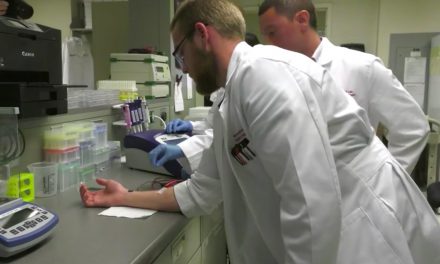An excrutiating spinal injury in 2001 led Tim Farquhar to Dr. Steven Simon, a pain doctor. Their meeting opened the door to over ten years of opioid addiction for Farquhar. Today, Dr. Simon is being sued by Farquhar and at least five other former patients who claim Simon prescribed them a highly addictive fentanyl spray because Insys Therapeutics, who manufacturers the spray, was paying him hundreds of thousands of dollars in speaking fees (aka kickbacks).
John Kapoor, the billionaire founder of Insys, was one of the company’s top brass. He, along with several others, was convicted last month in federal court in Boston of bribing doctors to make sales. The are all awaiting sentencing. New leadership at the company just agreed to pay $225 million to settle several whistleblower lawsuits related to the case, and a week later, Insys filed for bankruptcy.
RELATED STORY:
Farquhar, who is sick and not doing well, is worried that Simon may get off scot-free now that Insys has been prosecuted. Says Farquhar:
“I don’t know what the feds are doing. I don’t know if they’re still going after the doctors or whether they’re going to be content or just complacent with having (prosecuted) just Insys. But I’m scared they are.”
By the time the FBI knocked on his door in late 2014 or early 2015 asking about Simon, Farquhar was taking high doses of opioids, including the extremely addictive and potent drug fentanyl.
Farquhar is now off opioids following an excruciating withdrawal. He said he’d like to see more people held responsible for what happened to him, starting with Simon. But he also includes employees in Simon’s office and the pharmacies and drug distributors that failed to flag the unusually high amounts of the fentanyl spray, Subsys, that Simon was prescribing.
He also wants his story to be a warning for patients and providers, and to spread the word that there needs to be another option for pain other than addictive opioids.
Representatives of the FBI and the U.S. Attorney’s Offices of Kansas and Massachusetts said they could not comment on Farquhar’s case due the possibility of more indictments related to Insys. But it is beginning to appear that Simon had closer ties to the business side of Subsys that initially thought.
Currently, Farquhar’s lawsuit against Simon, Insys and others is moving forward in Johnson County District Court now that the criminal trial has ended. However, he said he is running out of time and money to pursue it.
RELATED STORY:
Simon has denied all accusations of wrongdoing and has stated that the payments from Insys never influenced his prescribing. He said he was acting in his best clinical judgment.
Since their initial meeting, Farquhar thought he and Simon were friends. Simon would sometimes spend an hour with him during appointments (while other patients barely got 15 minutes with Simon) and that he thought he really wanted to help him deal with the pain from spinal injury.
Farquhar knew Simon was out of town a lot for speaking engagements, and stated that the doctor would pre-sign blank prescriptions (he saw him sign the entire blank prescription pad on many occasions) for his staff to use when he was out of the office.
The fentanyl spray, Subsys, that Simon prescribed for Farquhar is intended for cancer patients, and it tightly controlled. However, records were altered for insurance purposes to make it look like it was prescribed for cancer pain, when it was actually going to a patient who hadn’t had cancer in years or, in some cases never had cancer.
Farquhar and other former patients who are now suing said that happened in Simon’s office. One plaintiff, Carole Tudhope, said Simon and Insys employees worked directly with the University of Kansas Cancer Center’s pharmacy near her home in Lee’s Summit to make sure she could get her Subsys there, even though she hadn’t had cancer for more than a decade. According to her suit, Simon was treating her for pain due to arthritis and fibromyalgia.
In addition to speaking for Insys, Simon was already a well-established pharmaceutical speaker in the pain medicine arena when Subsys was approved in 2012. Simon also served on an Insys advisory board, trained other physician speakers, and helped the company evaluate which doctors were likely to write a lot of Subsys prescriptions.
RELATED STORY:
The alleged main objective of Insys first came to light when one of its sales reps, Casey Hanoch, shared emails with his superiors, (including CEO Michael Babich) letting them know that he had gone with Simon to Oklahoma to talk to pain doctors about prescribing Subsys. When one of the doctors had concerns about the safety of the product and its potential for abuse, Hanoch stated:
“Dr. Simon addressed those concerns well, but Dr. Simon also recommended after we were finished that I follow up with another speaker in the future. We both agreed that the goal of this group practice as with all HCP’s (health care providers) that have yet to write (a Subsys prescription) is for them to try with their first patient as soon as possible.”
After meeting with another Oklahoma doctor, Hanoch wrote that he and his regional sales manager took Simon out to dinner “to discuss the likelihood of Subsys (prescriptions) being written.”
“We both agree as of right now I will not rely on him (the other doctor) to be a whale” — a lucrative target, Hanoch wrote. “However, we did make headway in discovering who the decision maker in the office was. His daughter is the the RN/semi-office manager and holds more weight than previously thought. The dinner was well worth it and due to everything I learned, the next two weeks will decide whether this office is worth being one of my top three offices or further down the list.”
RELATED:
In the years that followed, Simon was Insys’s top-paid Subsys speaker in Kansas, and one of the top 10 nationwide, making more than $200,000 from 2013 to 2015. During this time, Simon billed Medicare for significantly more Subsys prescriptions than any other doctor in the state of Kansas. His speaking payments are legal as long as they are not tied to an agreement to prescribe more of the drug. However, several whistleblowers came forward and revealed that was exactly what was happening, and started working with the feds to gather evidence of it.
So far, Simon has not been charged with a crime in connection to the Insys case, though the lawsuits assert that at least one of his Subsys patients died of a fentanyl overdose. Insys’ financial disclosure filings with the Securities and Exchange Commission indicate there are still ongoing state and federal investigations. The filings also disclosed that the company received investigative requests from several state Attorney General Offices that have ongoing investigations with the company. They also indicate that at least twelve doctors and nurse practitioners in other states face criminal charges.
But Farquhah said that is just not enough:
“To me, in my honest opinion, they’re letting the doctors play the stupid card. And these doctors, they knew what was going on.”
Source:












